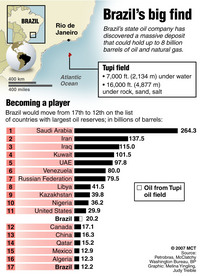 |
RIO DE JANEIRO,
Brazil — This
country, famed for
its development of
sugar-cane-produced
ethanol, soon could
become one of the
world's great oil
powers — if its
state-controlled
energy company,
Petrobras, can tap a
potentially massive
deposit beneath the
South Atlantic
Ocean.
Experts believe
the deposit, in the
Tupi field 180 miles
off the southeastern
Brazilian coast,
holds up to 8
billion barrels of
light oil and
natural gas. If
confirmed, the
deposit would be the
largest petroleum
find in seven years
and would propel
Brazil to the No. 12
position in oil
reserves, after the
United States and
ahead of Canada and
Mexico.
Analysts estimate
that the deposit
could be worth as
much as $60 billion
and predict that
Brazil, which last
year for the first
time produced as
much oil as it
consumed, could
become a major oil
exporter.
|
Yet the find will
challenge Petrobras'
reputation as one of
the world's best at
exploiting deep-sea
oil deposits.
About 70 percent
of Petrobras' oil
production comes
from deep-water
wells, making it the
world's biggest oil
producer at such
depths. But the Tupi
deposit is deeper
than Petrobras has
ever drilled — under
7,000 feet of ocean
water and more than
16,000 feet of rock,
sand and salt,
including a
1.2-mile-thick layer
of rock-hard salt.
How to tap into
the find has set off
a technological
race, spurred
because the
potential rewards of
exploiting the
deposit are so great
— especially as the
price of oil nears
$100 a barrel.
"It's among the
most complicated
projects in the
world in terms of
deep water," said
Caio Carvalhal, a
Brazil-based
research associate
with the U.S.
consulting firm
Cambridge Energy
Research Associates.
"But Petrobras has
proved in the past
that it is up to the
task."
Company officials
have said that years
of planning lie
ahead, and experts
estimate that the
Tupi field won't
start operating
fully until 2013.
Although the company
announced the find
last year, it just
released estimates
of its size in
November. The
company will have to
drill more wells to
better calculate the
size of the deposit.
"This was the
first time that we
arrived at this
depth, and the
technology is
expensive," said
Guilherme Estrella,
Petrobras' director
of exploration and
production. "The
costs are elevated,
but the quality of
the oil brings
robustness and
viability to this
investment."
The Tupi field is
the latest landmark
in a technological
race to the bottom
of the ocean that
many say is the
energy industry's
future.
Already, about a
third of world oil
production is
offshore, with as
much as 15 percent
coming from deep
waters, said energy
consultant David
Llewelyn, who's
worked extensively
in Brazil. Some of
the most promising
offshore oil regions
lie in the so-called
Golden Triangle,
made up of the Gulf
of Mexico and the
coasts of Brazil and
western Africa.
In 2005,
U.S.-based Chevron
and its partners
drilled the deepest
offshore oil and gas
well in history at
34,189 feet below
sea level in the
Gulf of Mexico,
according to
Transocean, the
world's largest
offshore drilling
contractor, which
completed the well.
The deepest onshore
well, at 37,016
feet, was completed
earlier this year on
Sakhalin Island, off
the Russian coast,
for ExxonMobil.
Last year,
Chevron announced it
had found one of the
biggest oil deposits
in the United
States, as much as
15 billion barrels
of petroleum, more
than 28,000 feet
below sea level in
the Gulf of Mexico.
"This is where
the industry has to
go to make the big
finds like this,"
said Thomas Marsh,
the Houston-based
vice president of
the consulting group
ODS-Petrodata, a
world leader in
offshore exploration
analysis. "And a lot
of money is being
spent on getting the
industry going where
it needs to go."
Oil companies
reach such
ultra-deep deposits
by lowering drill
bits into the ocean
floor through a
system of pipes
connected to a
floating platform on
the water's surface.
The pipes and drills
get smaller the
farther into the
ocean floor they
penetrate. At
maximum depth,
they're only about 8
inches wide, which
increases their
chances of being
damaged.
The dangers come
with the intense
water pressure and
heat, which can
damage even the
hardiest of metal
drills. Temperatures
30,000 feet below
the ocean floor can
reach 400 degrees
Fahrenheit, hot
enough to turn oil
into natural gas.
The biggest
technical challenge
of the Tupi deposit
is penetrating the
solid salt layer,
which can become a
kind of gel that
squeezes and resists
the drill bit. The
salt also can
interfere with sound
wave-based seismic
imaging that
engineers use to
figure out what's
below it.
The deposit's
location far from
the Brazilian coast
also complicates the
task of delivering
an estimated 53
million cubic feet
of natural gas daily
to consumers in the
project's pilot
phase.
Because natural
gas can't be stored,
Petrobras might have
to build an enormous
gas pipeline that
would stretch 180
miles to shore or
install gas
liquefaction
facilities above the
deposit to turn the
natural gas into
storable liquid.
Despite all the
difficulties,
Petrobras will rise
to the challenge,
said Marcio Rocha
Mello, president of
the Brazilian
Association of
Petroleum Geologists
and a former head of
the company's
geosciences section.
Before confirming
the Tupi find,
Petrobras already
had drilled 15 wells
into the solid salt
along Brazil's
southeastern coast,
mapping an undersea
basin of oil and gas
stretching about 500
miles long.
"We've already
put a lot of
training and
resources into
this," Rocha Mello
said. "The
technology involved
is already fully
understood. It's not
going to be a
problem."
Drilling the
first well alone
cost $240 million,
and tapping the Tupi
deposit will require
investing at least
$5 billion at the
outset, Llewelyn
said. Petrobras
controls a 65
percent stake in the
deposit, with
British company BG
Group and Portugal's
Gal Energia
controlling the
rest.
Petrobras has
made such
investments pay off
in the past largely
through innovation.
The company
pioneered the use of
floating platforms
to drill wells and
store oil and has
come up with new
ways to heat and
transport extracted
petroleum.
The company has
tried such
technology in more
than two dozen
countries, including
in the United
States, and shared
its know-how with
countries also
looking at going
deep. In the
process, Petrobras
has lowered its
costs for finding
new deposits.
And unlike state
energy companies in
Venezuela and
Mexico, Petrobras is
known as one of the
best-run firms in
the industry.
Innovation has
come with risks,
however, and even
tragedy. In 2001, a
Petrobras rig that
was then the largest
in the world caught
fire and sank off
the Rio de Janeiro
coast, killing 11
people.
Despite such
setbacks and the
enormous investments
required, the Tupi
discovery guarantees
that Petrobras will
be exploring the
ocean floor off the
Brazilian coast for
years to come.
"With a find this
size, the cost isn't
really an issue,"
said energy
consultant
Llewellyn. "You
really just have to
do it."



